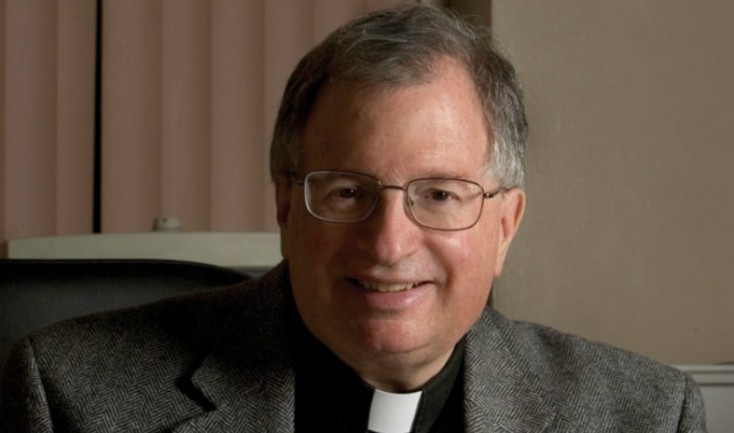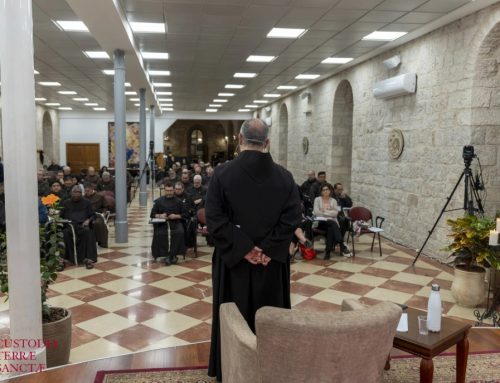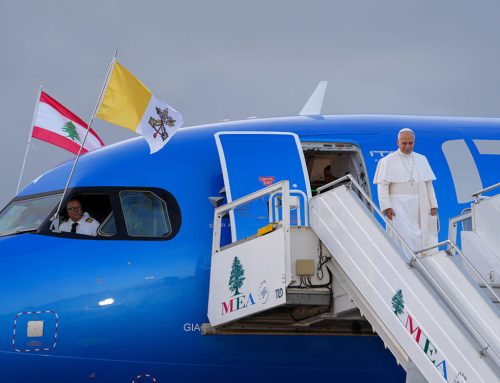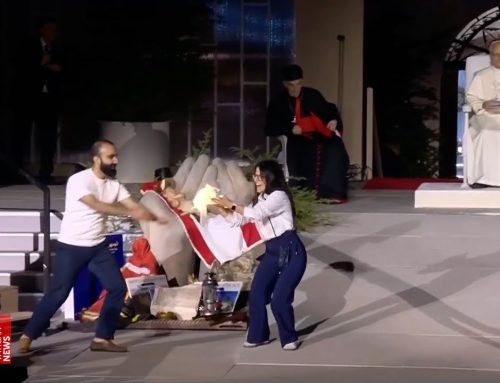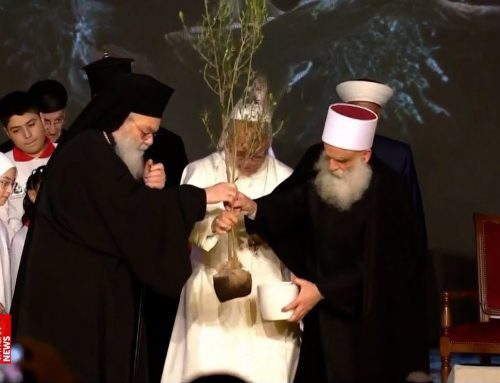A stone’s throw from the Church of the Holy Sepulchre lies the Mosque of Omar. The story goes that after the Muslim conquest of Jerusalem in 637 the Patriarch Sophronius invited the Caliph Omar to pray with him in what was then called, and the Orthodox still call, the Church of the Resurrection, but Omar declined not wanting to set a precedent which would endanger the site’s Christian status. He chose instead to pray outside the church at a spot legend had it that David had prayed.
As the Italians say, the legend “non e vero, mai ben trovato.” That is, the story may not be true, but you have to admit it is cleverly invented. For archeologists tell us that in the first decades after the conquest, Christians and Muslims prayed in the same sanctuaries. Whether you believe the legend or the archeologists, the lesson is that despite the conquest Christians and Muslims respected one another as people of faith, so they were able to worship side by side in their own ways. That has not been the case sometimes in the modern era.
On Mt. Zion, the third of the name, you will find the Cenacle, the supposed site of the Last Supper. It is actually a Crusader-era building. During Muslim times, it alternated between Christian and Muslim use, and sometimes it was a shared space. Among its architectural features even today is a mihrab, an Islamic prayer niche. Though Muslims no longer pray there, since Ottoman times the Franciscans pay an annual tax to retain it as a Christian site and save it from further encroachment. I say “further encroachment,” because after the capture of Jerusalem in the 1967 war an Orthodox Jewish sect occupied the first floor of the Cenacle and declared it the Tomb of David.
Contested Holy Places
The Cenacle holds an opposite lesson to the Mosque of Omar, namely, that in the Holy Land, shrines are also contested territory. The Holy Sepulchre itself is under the shared ownership of the Greek Orthodox, the Franciscans for the Latin (or Roman) Catholics, the Armenians and the Copts. The Syrian Orthodox still await their re-admission after their chapel was burned out a century ago, because the Greeks still refuse to assent to its reconstruction. In Hebron, the Tomb of the Patriarchs is divided between Muslim and Jewish sections. The barrier between the two sides was hardened there after Baruch Goldstein’s massacre there of 29 Muslims in 1994.
In recent years, the Government of Israel attempted at different times to make the minor Christian shrines, beginning with Mt. Tabor, Mensa Christi, a site on the lakeshore of the Sea of Galilee, and the excavated village of Capharnaum, also on the Lake, into national parks. Sites on the lakeshore are particularly desirable, as you can imagine, to Israeli tourists and the Israeli tourism industry.
Seizure of property takes place with both private and public initiatives. I recall two decades ago when the Sheikh Jirrah neighborhood near the Old Colony Hotel was an Arab enclave. Then an old tomb was found. It bore Greek inscriptions that identified it the tomb of a Greek matron of the Byzantine era. Without warning, an Israeli settler group claimed it was a Jewish tomb and access was closed off. Soon after, settlers prevented the expansion of an Arab house in the neighborhood which the municipal authorities had already approved. The expansion was delayed, then halted, and now the whole neighborhood is Jewish with high-rises housing newcomers from abroad. As a result, Arab and especially Arab Christian sensitivities over changes in property and residency rights is keen.
Land seizures, re-zonings, other prejudicial land regulations and broken agreements are the background for the much publicized closing of the Church of the Holy Sepulchre a few weeks ago. The Municipality of Jerusalem had announced taxes for church-held property and begun punitive processes, including freezing and confiscating bank accounts, to enforce its rulings. This is only the latest skirmish between the Municipality and the churches over the arnona, the local property tax.
During my years at the U.S. bishops’ conference (USCCB) from 1991 to 2004, I was asked to intervene a number of times on behalf of different Catholic and Christian agencies who were similarly impacted by earlier attempts to impose property taxes on church groups. Our appeal used to be that the Fundamental Agreement between the State of Israel and the Holy See, It stipulated that no new taxes would be imposed until the two parties had approved an agreement on fiscal and property issues. That appeal was closed to us when the Justice Ministry in a successful appeal to the High Court argued that the Fundamental Agreement was not binding on Israel. It was not binding, though signed and published in the government gazette, a site for public notification of laws and regulations binding on Israeli officials, because it had not ultimately been ratified by the Knesset. Indeed no Israeli government has seen fit to present it to the parliament for ratification.
Let it be said, the city has justification for its claims to tax church-owned property. The churches, especially the Greek Orthodox Church, are major land-owners in the city and around Israel. Much of that property is not used for religious purposes. It is income-producing rental and leased commercial and residential space.
The fiscal agreement was ultimately concluded after several years of negotiation. Following the U.S. model, the church property was to be tax-exempt and the commercial property taxed, but at a reduced rate. Unfortunately, the Fiscal Agreement has not taken effect. Thus, while the Catholic Church through the Holy See has diplomatic ties to the State of Israel other churches lack, diplomatic relations have not yielded the security for Catholic interests that proponents of the ties had promised. That’s why the Franciscan Custos stood in protest with representatives of the other churches at the closed doors of the Holy Sepulchre and why the protest listed the violation of international agreements as one of its complaints.
The Churches and International Policy
I open with the protest at the Holy Sepulchre and the struggles over municipal taxation to illustrate how and why Christian Arabs and the leaders of the churches in Jerusalem have grown sensitive to impositions by Israeli authorities. Only weeks before the closing of the Holy Sepulchre, the Patriarchs and Heads of Churches in Jerusalem had protested President Donald Trump’s unilateral recognition of Jerusalem as Israel’s capital. The vast majority of the Christian population consists of Palestinians, and the western (Latin, Anglican and Lutheran) churches have seen the defense of the rights of their Palestinian members as essential to their mission. Especially notable was the recognition of Palestinian claims to Jerusalem in the preamble to the Basic Agreement between the PLO and the Holy See in 2000. The penultimate preambular clause of the agreement’s preface read:
Declaring that an equitable solution for the issue of Jerusalem, based on international resolutions, is fundamental for a just and lasting peace in the Middle East, and that unilateral decisions and actions altering the specific character and status of Jerusalem are morally and legally unacceptable;[1]
The Preamble then went on to re-iterate the demand for “a special statute for Jerusalem, internationally guaranteed,” laying out specific provisions it hope to see in such a document.[2] Issued just before Pope John Paul II’s jubilee pilgrimage to the region in 2000, that clause provoked a good deal of consternation in Israel and among Jews worldwide, but it was soon forgotten in the wake of his historic visit. The Basic Agreement, of course, has been succeed by the sight of Pope Francis praying with his hand on the Palestinian side of the Israeli security wall in Bethlehem and the Holy See’s 2015 recognition of the State of Palestine.
From the time of the 1947 UN Partition Plan, the international community has recognized the unique significance of Jerusalem by designating it as a corpus separatum under international jurisdiction outside the Israeli and Arab areas of control. The Holy See held to that expectation until the Israeli occupation of Jerusalem in 1967. From that time the Holy See began to seek for a special statute for Jerusalem with particular attention to universal access to the city’s holy places. As time went on, it became clear that what the Holy See wanted was not merely a special status for the Holy City, but an internationally guaranteed special statute.
While the details of a possible statute would not be specified for some time, Pope Saint John Paul II in his 1983 apostolic letter Redemptionis anno laid out a theological vision for Jerusalem as a place of humanity’s encounter with God and a symbol of the unity for the human family. “Jerusalem was the historic site of the biblical revelation of God, the meeting place, as it were, of heaven and earth, in which more than in any other place the word of God was brought to men.” He continued, “Indeed, in so far as she is the homeland of the hearts of all the spiritual descendants of Abraham who hold her very dear, and the place where, according to faith, the created things of earth encounter the infinite transcendence of God. Jerusalem stands out as a symbol of coming together, of union, and of universal peace for the human family.”[3]
John Paul, a great friend of the Jewish people, also regarded Jerusalem as city for all peoples.[4] While open access to the holy places remains a symbol of Jerusalem’s status as a place of universal pilgrimage, John Paul’s concern extended to the living communities of believers there, Jewish, Christian and Muslim, as well. The nightmare for Christians was Jerusalem as a city of museums bereft of living communities of believers gathered round their sacred sites in worship. Thus, honoring the sacredness of Jerusalem entails preserving “Not only the monuments or the sacred places, but the whole historical Jerusalem and the existence of religious communities there . . .”[5]
Interreligious and Diplomatic Approaches To the Land and the City
Both as a matter of religious belief and of practical politics, the Catholic vision of John Paul II was universalistic. It esteems the historic and religious attachment of the Jewish people to the city. The universalistic vision, however, is in tension with the particularist vision of Jerusalem among contemporary ultra-Zionists as the united capital of Israel, a positon embraced by U. S. President Trump and his Evangelical advisers. The Holy See’s embrace of international law as the context in which to view the status of Jerusalem rests on the universalist vision of the post-Exilic prophets and the global outlook of Catholic Social Teaching as well as from the history out of which the modern State of Israel was born. From the Holy See’s perspective, the modern state was recognized by the United Nations, and so should be delimited by international law.
Responses to Philo-Judaic Catholics
Philo-Judaic Catholics are suspicious of the Holy See’s internationalist position as inconsistent with Nostra Aetate which recognized the Church’s debt to the Jewish people as the first recipients of revelation and the covenant.[6] In particular, the Second Vatican Council’s citation of “the promises” (Romans 9:4) is taken to justify the promise of the land. That text reads: “theirs is the sonship and the glory and the covenants and the law and the worship and the promises . . .” where the promises are taken to include the divine promise of the land, Eretz Israel.[7] I would argue that the philo-Judaic reading implies the precedence of the historical books of the bible to those like the post-Exilic prophets and the gospels with a universalistic hermeneutic.
The Patriarch Emeritus of Jerusalem Michel Sabbah, in his 1993 pastoral letter “Reading the Bible in the Land of the Bible,” offers a Christian interpretation of the land rooted in a universalistic revelation. “The worship of God is no longer linked to the possession of a specific land. The sole and absolute value is God and the worship of God in any place in the world.”[8] As Jesus says to the Samaritan woman in John’s Gospel, “Believe me, the hour is coming when neither on this mountain nor in Jerusalem will you worship the Father . . . true worshippers will worship the Father in spirit and truth. . .” (Jn 4:21, 23).
Sabbah argued that today we live in a different religious situation. In the past, “God was the God of armies. He fought with His people against the pagans.”[9] Today, he affirms, “humankind is better able to perceive God’s transcendence.” We are able to see God as he is: “the God who has chosen a people, but who is, at the same time Father of all His human creatures, and no longer a God of war, a friend of one people and fighting against another people.” So, there is a religious solution for co-habitation of the city by all believers in the one God. Indeed the early secular character of the Israeli state was intended in part to make that possible. The more recent steps to make Israel a professedly Jewish state—a state for Jews—make that more difficult, of course. So, Sabbah concludes:
Therefore, it is necessary to distinguish between the religious fact represented by the Jewish people, with its duties, obligations and religious responsibilities, and the political fact of a modern sovereign state . . .
In that spirit, the Holy See conducts Jewish relations through the Commission on Religious Relations with the Jews and those with the State of Israel through the Vatican diplomatic corps and the second section of the Secretariat of State for Relations with States.
The Patriarchs and Heads of Churches
Because of its size and worldwide diplomatic reach, the Catholic Church over a period of decades has laid out its expectations for the future of Jerusalem. In 1987 the appointment of Michel Sabbah as Patriarch of Jerusalem for the Latins gave the Arab Catholics of Israel and the then-Occupied Territories a voice of their own. At the same time, the First Intifada or Palestinian Uprising (1987-1993) brought Christians to put aside their ancient sectarian rivalries, work together and inspired their church leaders to speak out with a single voice.[10]
In December, 1993, the Vatican and Israel signed the Fundamental Agreement.[11] After a quarter century Israel is still to ratify that treaty. For a while, at least, there was a positive engagement on all sides, but by 1994 disappointments began to accumulate, particularly on the question of Jerusalem. In November of that year, the Patriarchs and Heads of Churches in Jerusalem, fourteen heads of the traditional Christian communities, published a memorandum affirming the need for a shared Jerusalem in opposition to exclusivist visions of the city then circulating in advance of final status talks set for 1996.[12]
Acknowledging the contentiousness of Jerusalem as one of the most difficult issues facing the negotiators in final status talks, they pleaded for an inclusive approach to the city’s future. “The experience of history teaches us,” they wrote, “that in order for Jerusalem to be a city of peace, no longer lusted after from the outside and thus a bone of contention between warring sides, it cannot belong exclusively to one people or to one religion. Jerusalem should be open to all, shared by all. Those who govern the city should make it ‘the capital of humankind.’”[13] In support of their vision, they cited an array of post-exilic prophetic texts, which concludes, “Jerusalem, aglow with the presence of God (Is 60:1), ought to be a city whose gates are always open (Is 1:1) with Peace as magistrate and Justice as government (Is 17).”
A statement by the Holy See Mission to the United Nations in July 2017 made clear its opposition to exclusivist claims to Jerusalem:
The Holy See believes that the rule of law, including respect for religious freedom and equality before the law based on the principle of citizenship and regardless of one’s race, ethnic origin or religion, is fundamental
toward the achievement and maintenance of the peaceful and fruitful coexistence among individuals, communities and nations in the whole region and beyond.[14]
The patriarchs and heads in their 1994 Memorandum listed their concerns for the particular legal protections they believed would be required in Jerusalem in the interest of a just peace:
- The human right of freedom of worship and of conscience, for both individuals and religious communities.
- Civil and historical rights that allow them to carry out their religious, educational, medical and other duties of charity.
- The right to have their own institutions, such as hospices for pilgrims, institutes for the study of the Bible . . . and the right to have their own personnel to run these institutions.
They appealed once again for a “special statute” for the city that would involve the international community as a guarantor.
Property Tax Conflicts
Over the past two and a half decades, the Patriarchs and Heads of Churches have continued to raise their voices in times of crisis to address pressing issues for the Christians of Jerusalem. The arnona, the municipal property taxes, have been a repeated source of frustration for the churches. During my time at the U.S. bishops’ conference in the 1990s I was called upon several times to make representations on behalf of the Latin Patriarchate and Catholic institutions to the Israeli government to re-instate the customary exemptions by reason of the Status Quo, the legal provisions which have held from Ottoman times, and later by appeal to the Fundamental Agreement. Its Article 4(a) stipulated that the status quo ante ought to hold in place until after a Fiscal Agreement had been ratified.[15]
At various times the mayor’s annual Christmas party for Christian leaders became an occasion for protest, when the church leaders would refuse to attend in protest of the attempted imposition. That was the case this past year, when the meeting had been postponed to February. The heads appealed to historic precedent and to the negative impacts of the taxes on their ministries. They declared that the arnona “both undermines the sacred character of Jerusalem, and jeopardizes the Church’s ability to conduct its ministry in this land on behalf of its communities and the world-wide church.”[16]
According to the Israel Times, in this last round of disputes over the arnona, the churches were caught in a political battle between Jerusalem Mayor Nir Bakat and the Israeli Finance Minister Moshe Kahlon. Last year the Finance Ministry had allocated a “capital allocation” of 700 million NIS to compensate the city for its alleged lost income, but the mayor regarded the allocation as too little to meet the city’s needs. Sometimes it’s not national policy, but local authorities and ambitious politicians who are at the root of the churches’ troubles.
Evangelicals, Christian Zionism and the Kairos Movement
I have been speaking about the historic churches in Jerusalem: Orthodox, Armenian, Catholic, Maronite, Melkite, Syriac, Copt and Chaldean. I have not commented on the position of Evangelical churches. On the whole, the ecumenical solidarity of the historic churches does not extend to the Evangelical churches. In part, that represents the estrangement of the old-timers from newcomers. But the distance between the historic churches and the Evangelicals is also due to tensions over Evangelical proselytism. Members of the historic churches are fearful of proselytism among Muslims, because they fear Muslim reaction to conversions rebounding on all Christians. Denied conversions among Muslims, Evangelicals sometimes attempt to convert baptized Christians of other denominations. The hierarchs regard this as “sheep stealing”; but in the Middle East where religious affiliation is a quasi-tribal membership, feelings over proselytism are even more intense. Antipathies become more aggravated when it comes to Christian Zionists. For in its embrace of the modern State of Israel, Christian Zionism has shown little, if any, regard for the ancient Christian communities of the Holy Land and their suffering under Israeli occupation and rule.
Christian Zionism is a movement, especially among American Evangelicals, based on the belief that the return of the Jews to the Holy Land and the establishment of the State of Israel in 1948 are signs of the immanent Second Coming of Jesus. For that reason, they are strong supporters, both politically and financially, of the State of Israel. Opposition of the historic churches to Christian Zionism was given its most articulate expression in the 2009 Kairos Palestine statement. Issued by Catholic, Orthodox and Protestant leaders, Kairos Palestine was a plea to end the occupation of Palestine through nonviolent resistance. In a thinly veiled reference to Christian Zionism, they asked their “sister Churches not to offer a theological cover-up for the injustice we suffer, for the sin of the occupation imposed upon us.”[17] The appeal engendered intense Israeli opposition because of its endorsement of BDS (Boycott, Divestment and Sanctions) as tools for bringing Israel to the negotiation table.
A more extensive critique of Christian Zionism and fuller defense of BDS as nonviolent tactics may be found in the 2012 American Christian statement Kairos USA. “Christian Zionism,” it argued, “supplants God’s gracious presence with the promise of land to one particular people that inevitably leads to the dispossession of other peoples.”[18] Christian Zionism is appealing to Americans, the statement argued, because of the sense of privilege both Americans and Israelis share as “chosen people.” “The notion . . . that the Jewish people have a special claim on Jerusalem and a superior right to the territory of historic Palestine over the other inhabitants of the land bears a resemblance,” the statement argues, “to our historic American notion of ‘Manifest Destiny’— our nation as the ‘shining city on a hill.’”[19]
President Trump’s unilateral recognition of a united Jerusalem as Israel’s capital in December, 2017, was influenced in part by his Evangelical Christian Zionist advisors.[20] On the other side, the heads of the historic churches in Jerusalem, had urged President Trump to avoid doing “irreparable harm” with a one-sided policy on Jerusalem.[21] In the wake of the president’s decision, the hierarchs implored him to revoke his decision.[22] “The Holy City,” they wrote, “can be shared and fully enjoyed once a political process helps liberate the hearts of all people that live within it from the conditions of conflict and destructiveness that they are experiencing.”[23]
The outlooks of American Christian Zionists and that of Jerusalem’s own Christians could not be more different. The Christian Zionists have added an unhappy complication to an already complex situation. Mr. Trump’s Jerusalem decision has made it all the more difficult to find a path to peace in the Holy Land.[24] Christian Zionists and the Trump Administration have made all the starker the choice between two visions of Jerusalem: one exclusivist and ethno-centric, the other an inclusive and universalist. There will be no peace until both sides acknowledge the suffering and the humanity of the other.
[1] See The Basic Agreement between the Holy See and the Palestine Liberation Organization at: https://www.vatican.va/roman_curia/secretariat_state/2000/documents/rc_seg-st_20000215_santa-sede-olp_en.html.
[2] These included: freedom of religion and conscience, equality before the law, identification of the sacred character of the city and its religious heritage, protection for the Holy Place and freedom of access to them, preservation of the “Status Quo” among the historic Christian bodies in the city.
[3] Redemptionis anno, apostolic letter April 20, 1984 at https://w2.vatican.va/content/john-paul-ii/en/apost_letters/1984.index.2.html.
[4] Psalm, 87 and Isaiah 2:3, 56:7.
[5] Redemptionis anno.
[6] Vatican Council II, Nosta Aetate (Declaration on the Relation of the Church to Non-Christian Religions), no. 4 at https://www.vatican.va/archive/hist_councils/ii_vatican_council/documents/vat-ii_decl_19651028_nostra-aetate_en.html.
[7] Ibid.
[8] Sabbah,“Reading the Bible in the Land of the Bible” in Drew Christiansen, S.J. and Saliba Sarsar, eds. Michel Sabbah, Faithful Witness: On Reconciliation and Peace in the Holy Land (New City, 2009}, 52.
[9] Ibid, 54.
[10] On the impact of popular opinion on collaboration of the leaders of the historic churches, see Peter De Brul, “The Crisis of Palestinian Christians’ in David Burrell and Yehezkel Landau, Voices from Jerusalem: Jews and Christians Reflect on the Holy Land (Paulist, 1992),118-58.
[11] For the text and commentary on the Fundamental Agreement, see Marshall Breger, ed. The Vatican-Israel Accords: Political, Legal and Theological Contexts (Notre Dame, 2004).
[12] For 1994 Memorandum of Their Beatitudes the Patriarchs and the heads of Christian communities in Jerusalem, see https://www.oikoumene.org/en/resources/documents/other-ecumenical-bodies/1994-memorandum-of-their-beatitudes-the-patriarchs-and-of-the-heads-of-christian-communities-in-jerusalem. For commentary, see Michel Sabbah, “Jerusalem” in Faithful Witness, 100-108.
The fullest articulation of Catholics hopes for Jerusalem appeared in then-Archbishop Jean-Louis Tauran’s 1998 to presidents of national bishops’ conferences, “The Question of Jerusalem,” at https://www.catholicculture.org/culture/library/view.cfm?id=670. Also, see Theodore E. McCarrick, “The Future of Jerusalem: Some Clsrifications” at https://www.usccb.org/issues-and-action/human-life-and-dignity/global-issues/middle-east/israel-palestine/some-clarifications-on-the-future-of-jerusalem-archbishop-mccarrick-1998-11-17.cfm.
[13] “Memorandum,” note 11 above
[14] From a statement on “The situation In the Middle East, including the Palestine question” by Msgr. Simon Kassas to the United Nations Security Council, July 17, 2017, .cfmhttps://mail.google.com/mail/u/0/#search/Kassas/1624eed84669a15c?projector=1&messagePartId=0.3.
[15] See Article 4.a of the “Legal Personality Agreement” (The Fiscal Agreement) in Vatican-Israel Accords, Appendix II, 365-8.
[16] See “Church heads to boycott mayor’s party over huge retroactive tax bills,” Israel Times, 15 February, 2018 at https://www.timesofisrael.com/church-heads-to-boycott-jerusalem-mayors-party-over-huge-retroactive-tax-bills/.
[17] “Kairos Palestine,” 6.1 at https://kairospalestine.ps/index.php/about-us/kairos-palestine-document.
[18] “Kairos USA,” 11 and 27 at https://kairosusa.org/wp-content/uploads/2013/12/Kairos-USA-Call-to-Action.pdf.
[19] Ibid, 11.
[20] For a review of Evangelical influence on President Trump, see Celia Belin. “Trump’s Jerusalem decision is a victory for Evangelical Politics,” Brookings Institution (2017) at: https://www.brookings.edu/blog/markaz/2017/12/15/trumps-jerusalem-decision-is-a-victory-for-evangelical-politics/.
[21] See “Christian Leaders Warned Trump against Recognizing Jerusalem as Israel’s Capital,” Huffington Post, 6 December 2017, at https://www.huffingtonpost.com/entry/christian-leaders-warned-trump-on-jerusalem_us_5a283173e4b02d3bfc37a9a5.
[22] “Orthodox Patriarch Theophilos and Heads of Local Churches Ask U.S. President to Revoke Jerusalem Decision,” Keep Talking Greece, December 8 2017, at https://www.keeptalkinggreece.com/2017/12/08/patriarch-churches-trump-jerusalem/.
[23] Letter of December 6 appended to “Orthodox Patriarch Theophilos,” note 20 above.
[24] For a detailed study of both local and international Christian positions on Jerusalem, see Julie Schumachmer Cohen, “A Christian Peacemaking Approach to Jerusalem” {Typescript from jschumachercohen@hotmail.com). It is especially instructive with respect to Palestinian Christian Protestant and Evangelical responses to Christian Zionism, 10-12.

